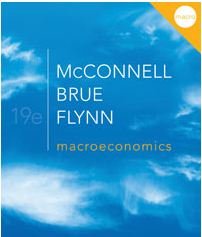Exam 3 Study Guide
Exam 3 RETAKE ADDITIONS:
- What happens to APS when incomes increase?
- MPC + MPS = 1
- determinants of investment demand
- Which has a bigger effect on AD (and therefore real GDP), a
change in government spending or the same change in taxes? Which
multiplier is larger, the simple multiplier (government spending
multiplier)or the tax multiplier?
- what are the built in stabilizers and how do they work?
- doe an actual budget deficit indicate expansionary fiscal
policy?
- What type of fiscal policy might also increase AS?
- assets and libilities of commercial banks
- what happen to bank balance sheets when a check is drawn and
cleared?
- the asset demand for money, the transaction demand for money,
and the total demand for money
- why is the money demand curve downward slopingwhy is the MS
curve a vertical line?
- assets and liabilities of the federal reserve banks
- how the Fed's monetary policy TOOLS affect a banks balance
sheet
- what is the most used TOOL of the Fed?
- what is the discount rate?
Define:
- crowding out effect
- standardized budget (also called full employment budget)
- multiplier effect
- investment demand graph
- MPC
- MPS
- M1
- M2
- FOMC (Federal Open Market Committee)
- quasi-public bank
- bank assets
- bank reserves
- bank liabilities
- excess reserves
- discount rate
- recognition lag
- operational lag
- administrative lag
- cyclical assymmetry
- Fed Funds rate
FISCAL POLICY
- legitimate concerns of a large public (government) debt
- full employment budget deficit vs. the an actual budget
deficit as an indicator of fiscal policy
- effect of a lump-sum tax on the consumption schedule (see
problem in yellow page quick quiz)
- MPC and the multiplier
- expansionary fiscal policy and the AD/AS graph -- when should
it be used?
- calculate multipliers
- government spending multiplier
- tax multiplier
- complex multiplier
- calculate MPC using a table AND a graph
- shifts in the investment demand curve (determinants of
investment EXCEPT interest rates)
- why is the investment demand curve downward sloping? (expected
rates of return and interest rates)
MONETARY POLICY
- functions of money
- what "backs" the money supply
- who controls the money supply
- structure of the Federal Reserve, the Board of Governors, the
FOMC
- why are the Fed banks called "quasi-public" banks
- goldsmith banking and their ability to create money
- commercial bank reserves and liabilities AND the Fed bank
reserves and liabilities
- what is the main purpose of the legal reserves requirement
(also call required reserves)
- how banks create money (see yellow pages and online lecture
(chapter 15)
- calculate excess reserves
- calculate the money multiplier
- calculate the largest loan that a single bank can safely
make (= excess reserves)
- calculate the possible change in the money supply for the
banking system (change in MS = excess reserves x the money
multiplier)
- how the Fed controls the money supply
- tools of the Fed
- using balance sheets you will need to calculate
- how much OMO (open market operations) will change the
money supply
- how much a change in the required reservces will change
the money supply
- understand the 3-graph model of how monetary policy works
!!!!!
- the cause-effect change of expansionary monetary policy
- time lags: fiscal policy vs. monetary policy
EXTRA CREDIT ESSAY QUESTION
- there will be a short news article that discusses a monetary
policy action taken by the Fed
- you need to:
- identify and discuss the TOOL used by the Fed (Fed Funds
rate = OMO tool)
- show the effects of the action on the 3-graph model
- and discuss the effects of the action on unemployment (UE),
inflation (IN), and economic growth (EG)
